We Can, But Dare We? Healthcare Ethics and Legislations Related to Patient Privacy
VerifiedAdded on 2023/05/29
|8
|1794
|403
AI Summary
This report discusses healthcare ethics and legislations related to patient privacy, through the lens of HIPAA rules and regulations. It also discusses the advantages and disadvantages of using smartphones and social media in healthcare. The report concludes with possible recommendations and a scenario ending.
Contribute Materials
Your contribution can guide someone’s learning journey. Share your
documents today.
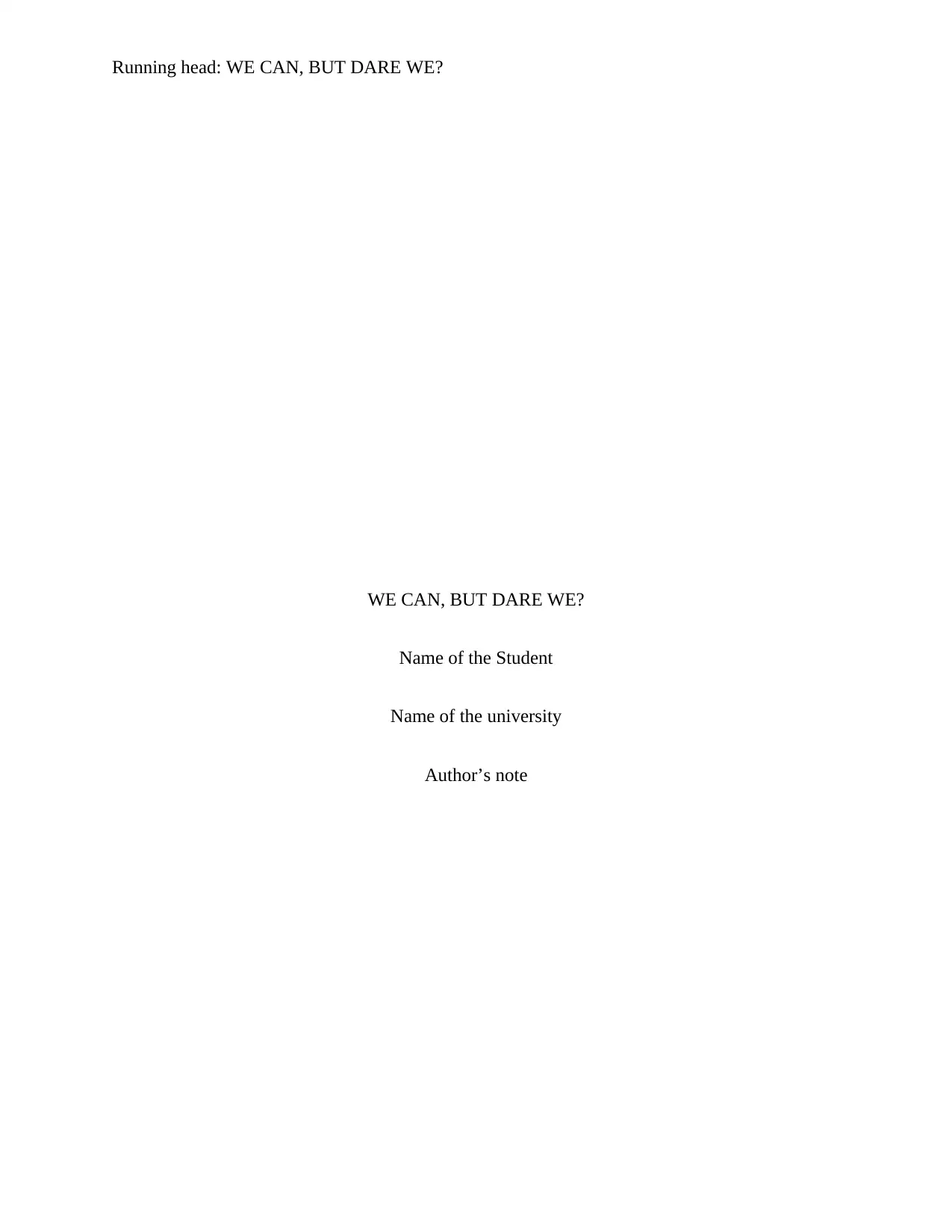
Running head: WE CAN, BUT DARE WE?
WE CAN, BUT DARE WE?
Name of the Student
Name of the university
Author’s note
WE CAN, BUT DARE WE?
Name of the Student
Name of the university
Author’s note
Secure Best Marks with AI Grader
Need help grading? Try our AI Grader for instant feedback on your assignments.
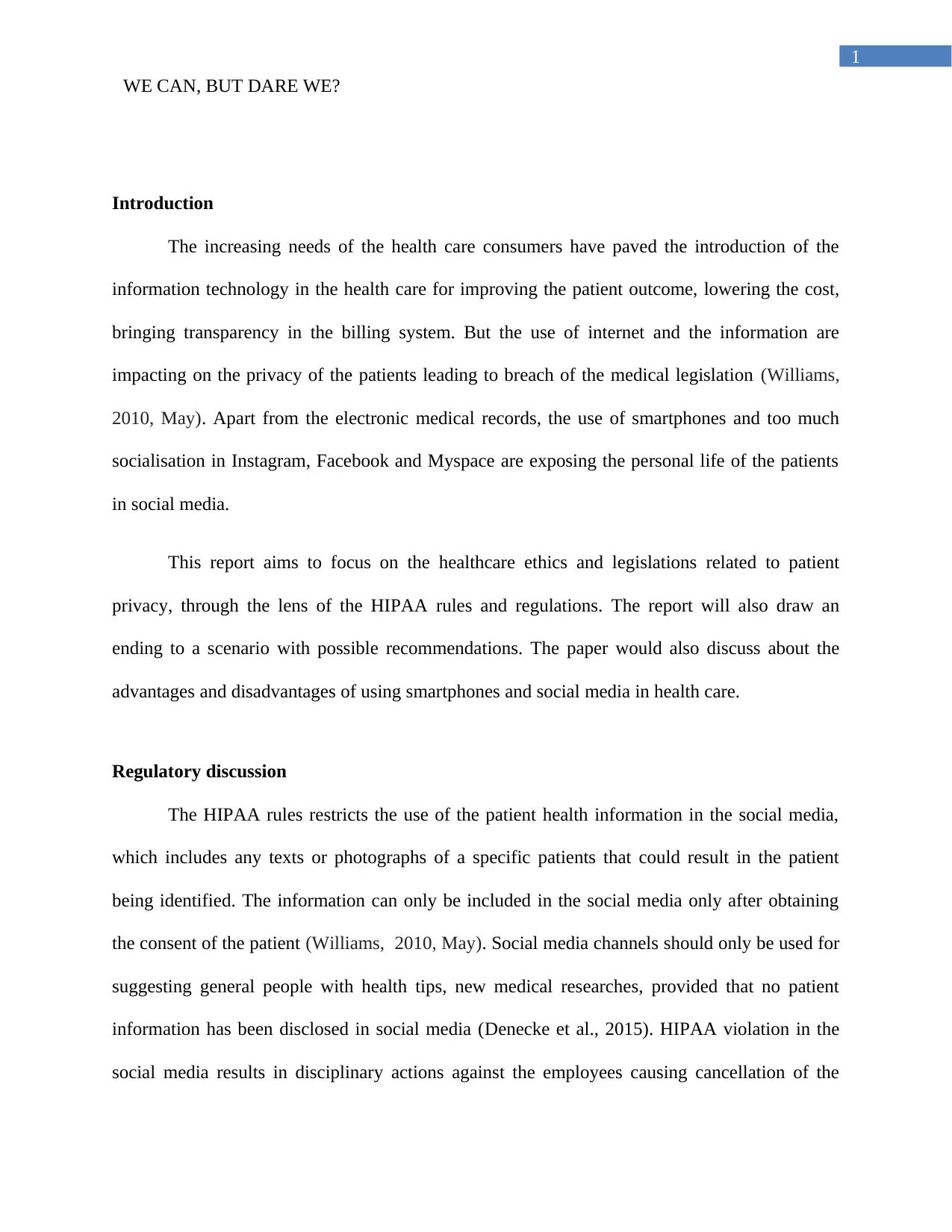
1
WE CAN, BUT DARE WE?
Introduction
The increasing needs of the health care consumers have paved the introduction of the
information technology in the health care for improving the patient outcome, lowering the cost,
bringing transparency in the billing system. But the use of internet and the information are
impacting on the privacy of the patients leading to breach of the medical legislation (Williams,
2010, May). Apart from the electronic medical records, the use of smartphones and too much
socialisation in Instagram, Facebook and Myspace are exposing the personal life of the patients
in social media.
This report aims to focus on the healthcare ethics and legislations related to patient
privacy, through the lens of the HIPAA rules and regulations. The report will also draw an
ending to a scenario with possible recommendations. The paper would also discuss about the
advantages and disadvantages of using smartphones and social media in health care.
Regulatory discussion
The HIPAA rules restricts the use of the patient health information in the social media,
which includes any texts or photographs of a specific patients that could result in the patient
being identified. The information can only be included in the social media only after obtaining
the consent of the patient (Williams, 2010, May). Social media channels should only be used for
suggesting general people with health tips, new medical researches, provided that no patient
information has been disclosed in social media (Denecke et al., 2015). HIPAA violation in the
social media results in disciplinary actions against the employees causing cancellation of the
WE CAN, BUT DARE WE?
Introduction
The increasing needs of the health care consumers have paved the introduction of the
information technology in the health care for improving the patient outcome, lowering the cost,
bringing transparency in the billing system. But the use of internet and the information are
impacting on the privacy of the patients leading to breach of the medical legislation (Williams,
2010, May). Apart from the electronic medical records, the use of smartphones and too much
socialisation in Instagram, Facebook and Myspace are exposing the personal life of the patients
in social media.
This report aims to focus on the healthcare ethics and legislations related to patient
privacy, through the lens of the HIPAA rules and regulations. The report will also draw an
ending to a scenario with possible recommendations. The paper would also discuss about the
advantages and disadvantages of using smartphones and social media in health care.
Regulatory discussion
The HIPAA rules restricts the use of the patient health information in the social media,
which includes any texts or photographs of a specific patients that could result in the patient
being identified. The information can only be included in the social media only after obtaining
the consent of the patient (Williams, 2010, May). Social media channels should only be used for
suggesting general people with health tips, new medical researches, provided that no patient
information has been disclosed in social media (Denecke et al., 2015). HIPAA violation in the
social media results in disciplinary actions against the employees causing cancellation of the
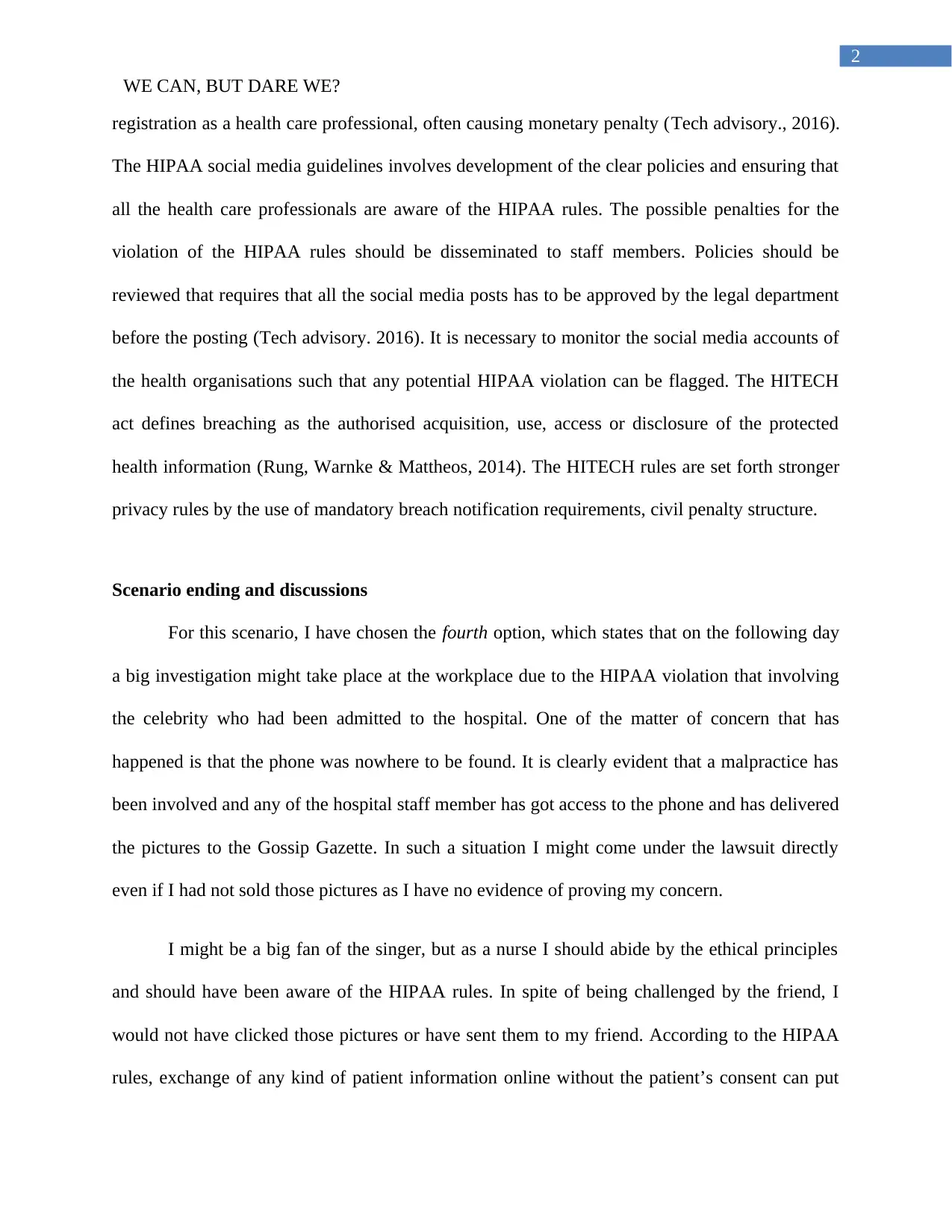
2
WE CAN, BUT DARE WE?
registration as a health care professional, often causing monetary penalty (Tech advisory., 2016).
The HIPAA social media guidelines involves development of the clear policies and ensuring that
all the health care professionals are aware of the HIPAA rules. The possible penalties for the
violation of the HIPAA rules should be disseminated to staff members. Policies should be
reviewed that requires that all the social media posts has to be approved by the legal department
before the posting (Tech advisory. 2016). It is necessary to monitor the social media accounts of
the health organisations such that any potential HIPAA violation can be flagged. The HITECH
act defines breaching as the authorised acquisition, use, access or disclosure of the protected
health information (Rung, Warnke & Mattheos, 2014). The HITECH rules are set forth stronger
privacy rules by the use of mandatory breach notification requirements, civil penalty structure.
Scenario ending and discussions
For this scenario, I have chosen the fourth option, which states that on the following day
a big investigation might take place at the workplace due to the HIPAA violation that involving
the celebrity who had been admitted to the hospital. One of the matter of concern that has
happened is that the phone was nowhere to be found. It is clearly evident that a malpractice has
been involved and any of the hospital staff member has got access to the phone and has delivered
the pictures to the Gossip Gazette. In such a situation I might come under the lawsuit directly
even if I had not sold those pictures as I have no evidence of proving my concern.
I might be a big fan of the singer, but as a nurse I should abide by the ethical principles
and should have been aware of the HIPAA rules. In spite of being challenged by the friend, I
would not have clicked those pictures or have sent them to my friend. According to the HIPAA
rules, exchange of any kind of patient information online without the patient’s consent can put
WE CAN, BUT DARE WE?
registration as a health care professional, often causing monetary penalty (Tech advisory., 2016).
The HIPAA social media guidelines involves development of the clear policies and ensuring that
all the health care professionals are aware of the HIPAA rules. The possible penalties for the
violation of the HIPAA rules should be disseminated to staff members. Policies should be
reviewed that requires that all the social media posts has to be approved by the legal department
before the posting (Tech advisory. 2016). It is necessary to monitor the social media accounts of
the health organisations such that any potential HIPAA violation can be flagged. The HITECH
act defines breaching as the authorised acquisition, use, access or disclosure of the protected
health information (Rung, Warnke & Mattheos, 2014). The HITECH rules are set forth stronger
privacy rules by the use of mandatory breach notification requirements, civil penalty structure.
Scenario ending and discussions
For this scenario, I have chosen the fourth option, which states that on the following day
a big investigation might take place at the workplace due to the HIPAA violation that involving
the celebrity who had been admitted to the hospital. One of the matter of concern that has
happened is that the phone was nowhere to be found. It is clearly evident that a malpractice has
been involved and any of the hospital staff member has got access to the phone and has delivered
the pictures to the Gossip Gazette. In such a situation I might come under the lawsuit directly
even if I had not sold those pictures as I have no evidence of proving my concern.
I might be a big fan of the singer, but as a nurse I should abide by the ethical principles
and should have been aware of the HIPAA rules. In spite of being challenged by the friend, I
would not have clicked those pictures or have sent them to my friend. According to the HIPAA
rules, exchange of any kind of patient information online without the patient’s consent can put
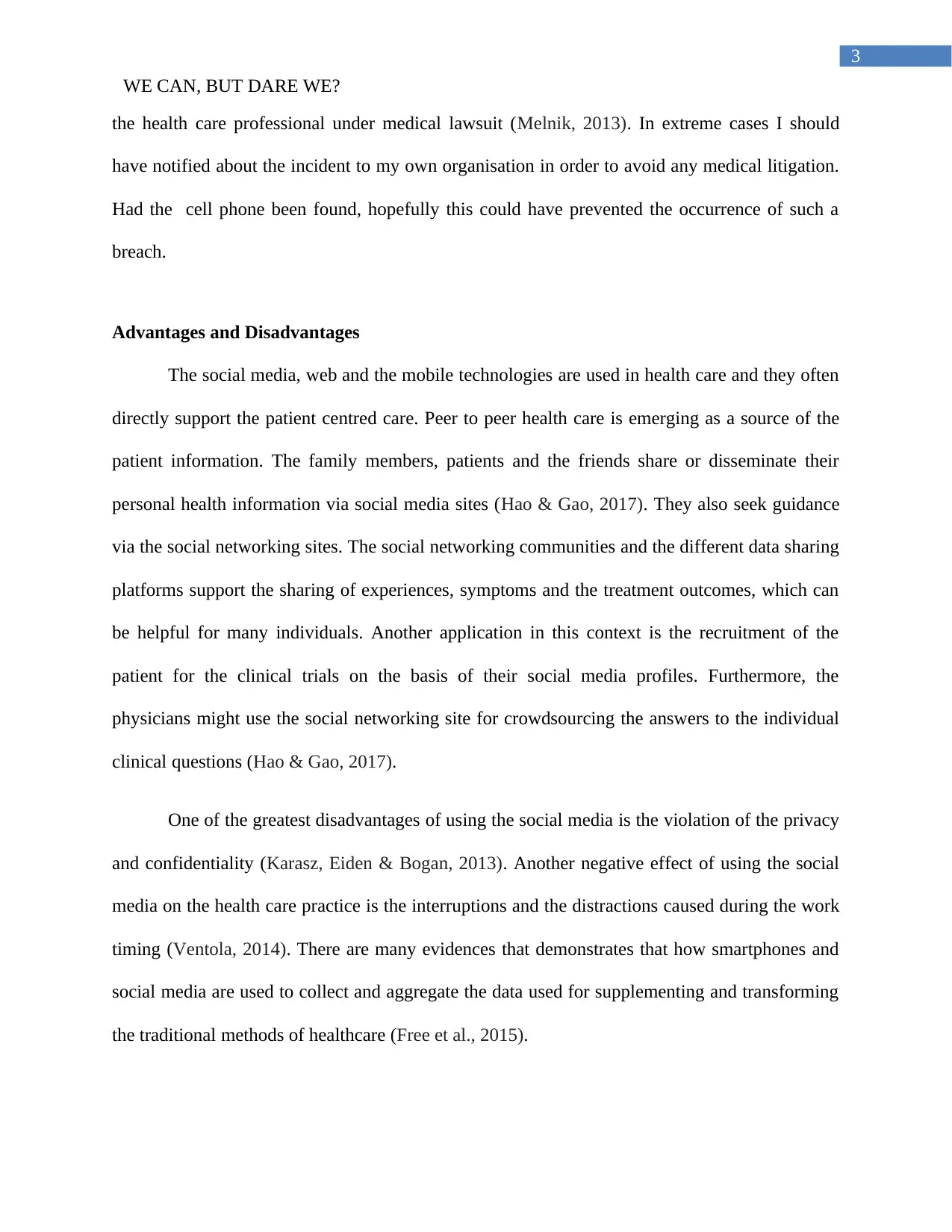
3
WE CAN, BUT DARE WE?
the health care professional under medical lawsuit (Melnik, 2013). In extreme cases I should
have notified about the incident to my own organisation in order to avoid any medical litigation.
Had the cell phone been found, hopefully this could have prevented the occurrence of such a
breach.
Advantages and Disadvantages
The social media, web and the mobile technologies are used in health care and they often
directly support the patient centred care. Peer to peer health care is emerging as a source of the
patient information. The family members, patients and the friends share or disseminate their
personal health information via social media sites (Hao & Gao, 2017). They also seek guidance
via the social networking sites. The social networking communities and the different data sharing
platforms support the sharing of experiences, symptoms and the treatment outcomes, which can
be helpful for many individuals. Another application in this context is the recruitment of the
patient for the clinical trials on the basis of their social media profiles. Furthermore, the
physicians might use the social networking site for crowdsourcing the answers to the individual
clinical questions (Hao & Gao, 2017).
One of the greatest disadvantages of using the social media is the violation of the privacy
and confidentiality (Karasz, Eiden & Bogan, 2013). Another negative effect of using the social
media on the health care practice is the interruptions and the distractions caused during the work
timing (Ventola, 2014). There are many evidences that demonstrates that how smartphones and
social media are used to collect and aggregate the data used for supplementing and transforming
the traditional methods of healthcare (Free et al., 2015).
WE CAN, BUT DARE WE?
the health care professional under medical lawsuit (Melnik, 2013). In extreme cases I should
have notified about the incident to my own organisation in order to avoid any medical litigation.
Had the cell phone been found, hopefully this could have prevented the occurrence of such a
breach.
Advantages and Disadvantages
The social media, web and the mobile technologies are used in health care and they often
directly support the patient centred care. Peer to peer health care is emerging as a source of the
patient information. The family members, patients and the friends share or disseminate their
personal health information via social media sites (Hao & Gao, 2017). They also seek guidance
via the social networking sites. The social networking communities and the different data sharing
platforms support the sharing of experiences, symptoms and the treatment outcomes, which can
be helpful for many individuals. Another application in this context is the recruitment of the
patient for the clinical trials on the basis of their social media profiles. Furthermore, the
physicians might use the social networking site for crowdsourcing the answers to the individual
clinical questions (Hao & Gao, 2017).
One of the greatest disadvantages of using the social media is the violation of the privacy
and confidentiality (Karasz, Eiden & Bogan, 2013). Another negative effect of using the social
media on the health care practice is the interruptions and the distractions caused during the work
timing (Ventola, 2014). There are many evidences that demonstrates that how smartphones and
social media are used to collect and aggregate the data used for supplementing and transforming
the traditional methods of healthcare (Free et al., 2015).
Secure Best Marks with AI Grader
Need help grading? Try our AI Grader for instant feedback on your assignments.
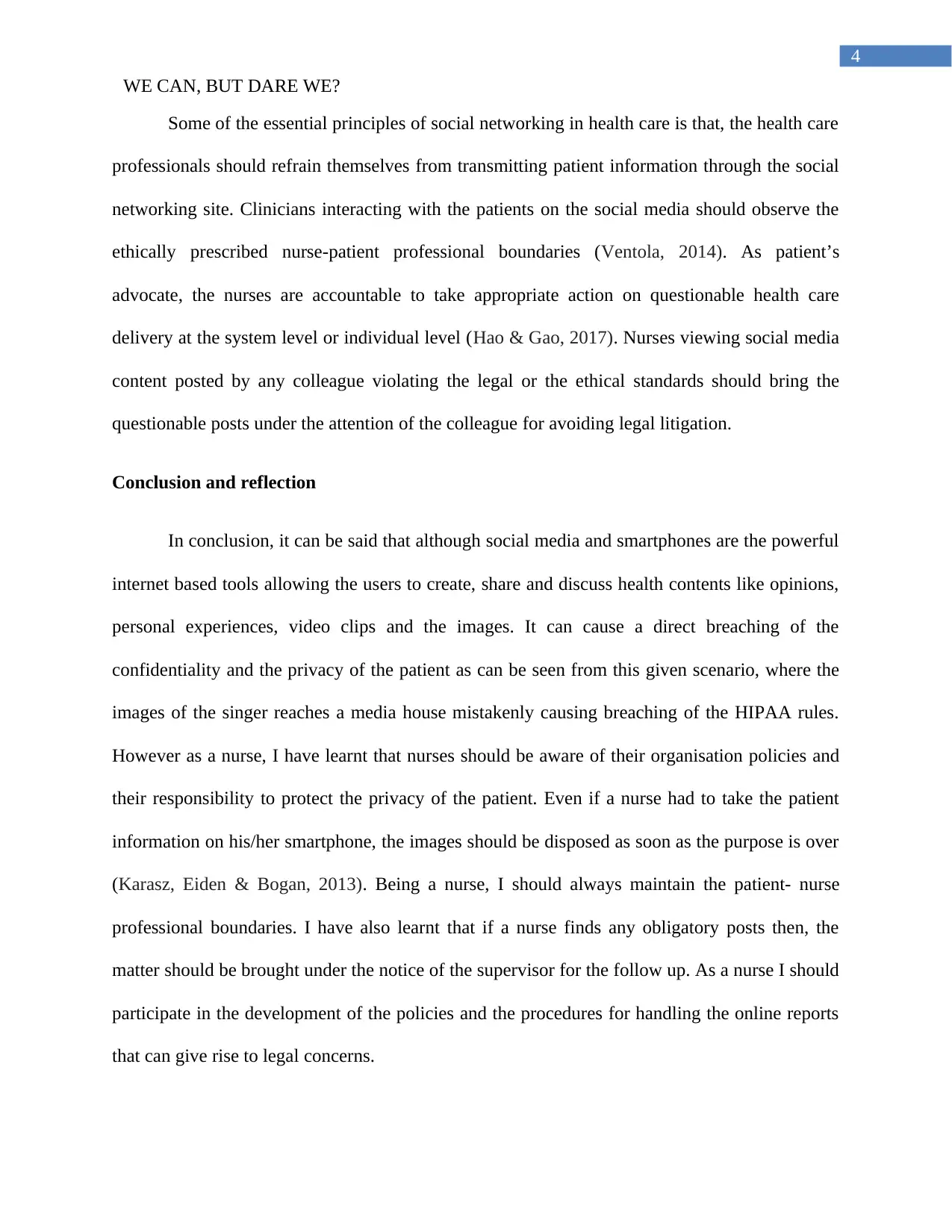
4
WE CAN, BUT DARE WE?
Some of the essential principles of social networking in health care is that, the health care
professionals should refrain themselves from transmitting patient information through the social
networking site. Clinicians interacting with the patients on the social media should observe the
ethically prescribed nurse-patient professional boundaries (Ventola, 2014). As patient’s
advocate, the nurses are accountable to take appropriate action on questionable health care
delivery at the system level or individual level (Hao & Gao, 2017). Nurses viewing social media
content posted by any colleague violating the legal or the ethical standards should bring the
questionable posts under the attention of the colleague for avoiding legal litigation.
Conclusion and reflection
In conclusion, it can be said that although social media and smartphones are the powerful
internet based tools allowing the users to create, share and discuss health contents like opinions,
personal experiences, video clips and the images. It can cause a direct breaching of the
confidentiality and the privacy of the patient as can be seen from this given scenario, where the
images of the singer reaches a media house mistakenly causing breaching of the HIPAA rules.
However as a nurse, I have learnt that nurses should be aware of their organisation policies and
their responsibility to protect the privacy of the patient. Even if a nurse had to take the patient
information on his/her smartphone, the images should be disposed as soon as the purpose is over
(Karasz, Eiden & Bogan, 2013). Being a nurse, I should always maintain the patient- nurse
professional boundaries. I have also learnt that if a nurse finds any obligatory posts then, the
matter should be brought under the notice of the supervisor for the follow up. As a nurse I should
participate in the development of the policies and the procedures for handling the online reports
that can give rise to legal concerns.
WE CAN, BUT DARE WE?
Some of the essential principles of social networking in health care is that, the health care
professionals should refrain themselves from transmitting patient information through the social
networking site. Clinicians interacting with the patients on the social media should observe the
ethically prescribed nurse-patient professional boundaries (Ventola, 2014). As patient’s
advocate, the nurses are accountable to take appropriate action on questionable health care
delivery at the system level or individual level (Hao & Gao, 2017). Nurses viewing social media
content posted by any colleague violating the legal or the ethical standards should bring the
questionable posts under the attention of the colleague for avoiding legal litigation.
Conclusion and reflection
In conclusion, it can be said that although social media and smartphones are the powerful
internet based tools allowing the users to create, share and discuss health contents like opinions,
personal experiences, video clips and the images. It can cause a direct breaching of the
confidentiality and the privacy of the patient as can be seen from this given scenario, where the
images of the singer reaches a media house mistakenly causing breaching of the HIPAA rules.
However as a nurse, I have learnt that nurses should be aware of their organisation policies and
their responsibility to protect the privacy of the patient. Even if a nurse had to take the patient
information on his/her smartphone, the images should be disposed as soon as the purpose is over
(Karasz, Eiden & Bogan, 2013). Being a nurse, I should always maintain the patient- nurse
professional boundaries. I have also learnt that if a nurse finds any obligatory posts then, the
matter should be brought under the notice of the supervisor for the follow up. As a nurse I should
participate in the development of the policies and the procedures for handling the online reports
that can give rise to legal concerns.
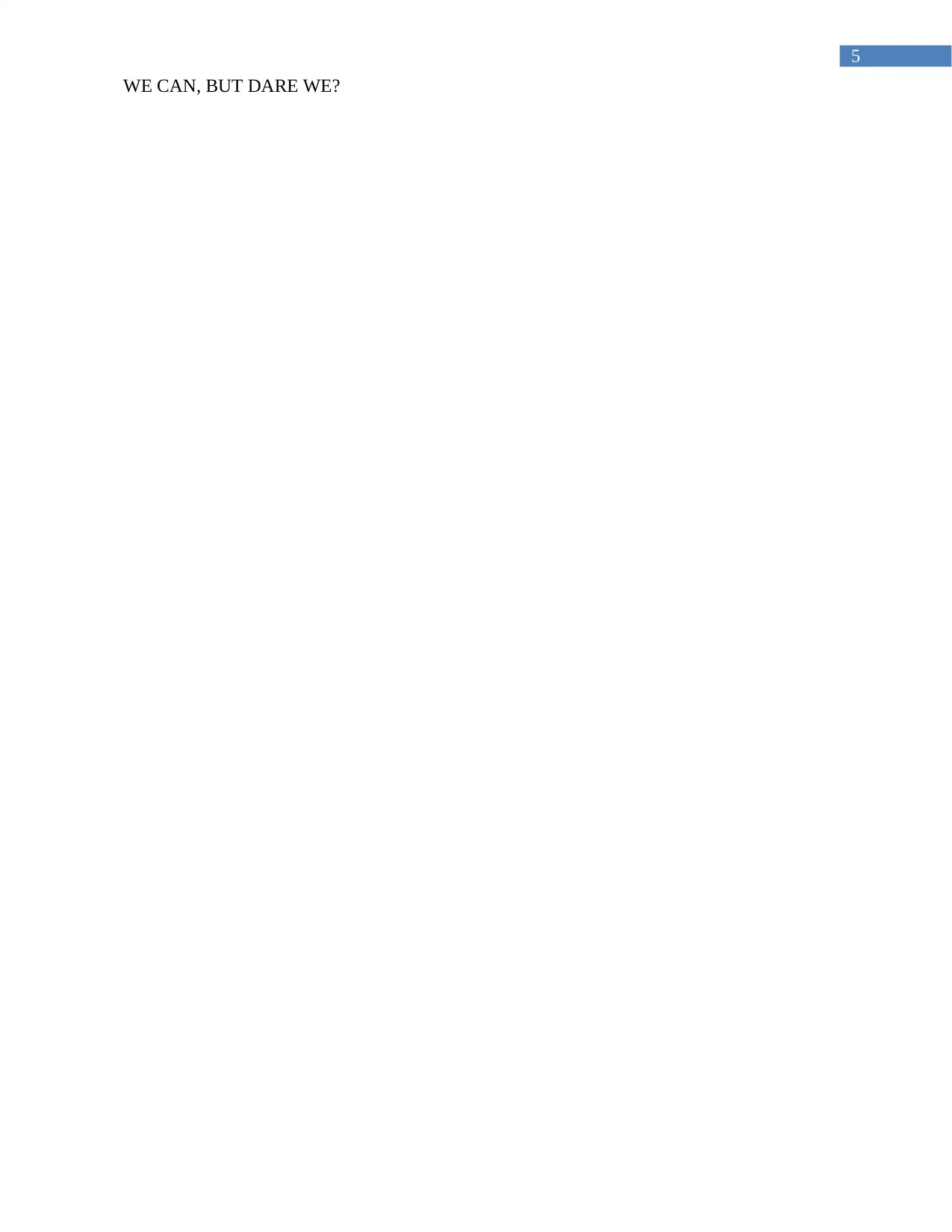
5
WE CAN, BUT DARE WE?
WE CAN, BUT DARE WE?

6
WE CAN, BUT DARE WE?
References
Denecke, K., Bamidis, P., Bond, C., Gabarron, E., Househ, M., Lau, A. Y., Mayer, M. A.,
Merolli, M., … Hansen, M. (2015). Ethical Issues of Social Media Usage in
Healthcare. Yearbook of medical informatics, 10(1), 137-47.
Free, C., Phillips, G., Watson, L., Galli, L., Felix, L., Edwards, P., ... & Haines, A. (2013). The
effectiveness of mobile-health technologies to improve health care service delivery
processes: a systematic review and meta-analysis. PLoS medicine, 10(1), e1001363.
https://doi.org/10.1371/journal.pmed.1001363
Hao, J., & Gao, B. (2017). Advantages and Disadvantages for Nurses of Using Social
Media. of, 3, 2. Access date: 14.11.2018. Retrieved from:https://www.scientonline.org/
Karasz, H. N., Eiden, A., & Bogan, S. (2013). Text messaging to communicate with public
health audiences: how the HIPAA Security Rule affects practice. American journal of
public health, 103(4), 617-622. doi/abs/10.2105/AJPH.2012.300999
Melnik, T. (2013). Avoiding violations of patient privacy with social media. Journal of Nursing
Regulation, 3(4), 39-46. doi.org/10.1016/S2155-8256(15)30185-X
Rung, A., Warnke, F., & Mattheos, N. (2014). Investigating the use of smartphones for learning
purposes by Australian dental students. JMIR mHealth and uHealth, 2(2).
doi: [10.2196/mhealth.3120]
WE CAN, BUT DARE WE?
References
Denecke, K., Bamidis, P., Bond, C., Gabarron, E., Househ, M., Lau, A. Y., Mayer, M. A.,
Merolli, M., … Hansen, M. (2015). Ethical Issues of Social Media Usage in
Healthcare. Yearbook of medical informatics, 10(1), 137-47.
Free, C., Phillips, G., Watson, L., Galli, L., Felix, L., Edwards, P., ... & Haines, A. (2013). The
effectiveness of mobile-health technologies to improve health care service delivery
processes: a systematic review and meta-analysis. PLoS medicine, 10(1), e1001363.
https://doi.org/10.1371/journal.pmed.1001363
Hao, J., & Gao, B. (2017). Advantages and Disadvantages for Nurses of Using Social
Media. of, 3, 2. Access date: 14.11.2018. Retrieved from:https://www.scientonline.org/
Karasz, H. N., Eiden, A., & Bogan, S. (2013). Text messaging to communicate with public
health audiences: how the HIPAA Security Rule affects practice. American journal of
public health, 103(4), 617-622. doi/abs/10.2105/AJPH.2012.300999
Melnik, T. (2013). Avoiding violations of patient privacy with social media. Journal of Nursing
Regulation, 3(4), 39-46. doi.org/10.1016/S2155-8256(15)30185-X
Rung, A., Warnke, F., & Mattheos, N. (2014). Investigating the use of smartphones for learning
purposes by Australian dental students. JMIR mHealth and uHealth, 2(2).
doi: [10.2196/mhealth.3120]
Paraphrase This Document
Need a fresh take? Get an instant paraphrase of this document with our AI Paraphraser

7
WE CAN, BUT DARE WE?
Tech advisory., (2016).Social Media and HIPAA Compliance. Access date: 14.11.2018.
Retrieved from:https://www.techadvisory.org/2018/05/social-media-and-hipaa-
compliance/
Ventola, C. L. (2014). Social media and health care professionals: benefits, risks, and best
practices. Pharmacy and Therapeutics, 39(7), 491.
https://www.ncbi.nlm.nih.gov/pmc/articles/PMC4103576/
Williams, J. (2010, May). Social networking applications in health care: threats to the privacy
and security of health information. In Proceedings of the 2010 ICSE workshop on
software engineering in health care (pp. 39-49). ACM. doi>10.1145/1809085.1809091
WE CAN, BUT DARE WE?
Tech advisory., (2016).Social Media and HIPAA Compliance. Access date: 14.11.2018.
Retrieved from:https://www.techadvisory.org/2018/05/social-media-and-hipaa-
compliance/
Ventola, C. L. (2014). Social media and health care professionals: benefits, risks, and best
practices. Pharmacy and Therapeutics, 39(7), 491.
https://www.ncbi.nlm.nih.gov/pmc/articles/PMC4103576/
Williams, J. (2010, May). Social networking applications in health care: threats to the privacy
and security of health information. In Proceedings of the 2010 ICSE workshop on
software engineering in health care (pp. 39-49). ACM. doi>10.1145/1809085.1809091
1 out of 8
Related Documents
Your All-in-One AI-Powered Toolkit for Academic Success.
+13062052269
info@desklib.com
Available 24*7 on WhatsApp / Email
![[object Object]](/_next/static/media/star-bottom.7253800d.svg)
Unlock your academic potential
© 2024 | Zucol Services PVT LTD | All rights reserved.





